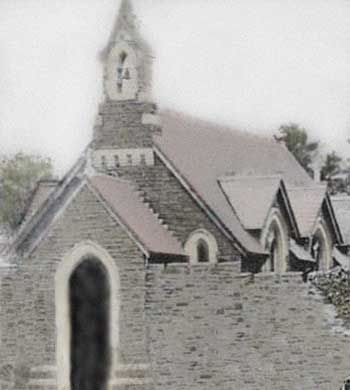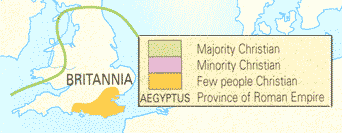Saint Aaron of Caerleon, (303 A.D.), British martyr, persecuted under the rule of Roman emperor Diocletian and for whose churches post-Roman Caerleon became famous. His name was recorded by Christian historians St. Gildas and Bede. He was friend of Saint Julius and may have been Britain's proto-martyr.
His feast day falls on July 1. In his De Excidio Britanniae, Gildas writes: "God… in the… time of persecution… lest Britain should be completely enveloped in the thick darkness of black night, kindled for us bright lamps of holy martyrs…..I speak of Saint Alban of Verulamium, Aaron and Julius, citizens of Caerleon, and the rest of both sexes in different places, who stood firm with lofty nobleness of mind in Christ's battle."
The city Caerleon was an important center of early celtic Christianity in Britain. The bishop of Caerleon was present during the first council of western Christianity at the Synod of Arles in 314. Caerleon remained Wales' bishopric until it was transferred to St David's in the 6th century by David himself. A monastery of canons served St Julius' church, along with a college of 200 'learned men', so Geoffrey of Monmouth says, 'who were skilled in astrology and the other arts'. He claimed that Caerleon was one of the three major sees of Britain.

St. Julius, Aaron & David Catholic Church
Reconstruction based on historical photographs of the church.
The church is located in Caerleon, Monmouthshire, Wales.
The precise date Christianity first came to Britain is unknown, but it may be contemporary with Christianity's arrival in Gaul. Tertullian, writing in about 200, states 'the Gospel was preached in parts of the island which the arms of Rome had not yet penetrated', and Origen, c.240, alludes to the Christian faith as 'unifying force among the Britons', although Origen also claims 'many Britons had not yet heard of the Gospels'. This suggests that by around 200 A.D., Christianity in Britain was at least known, and in the Empire as a whole, for both Tertullian and Origen recorded as much, far away.
Traditions of the earliest British martyrs, St. Alban of Verulamium and Aaron and Julian of Caerleon, appear certainly to be early, though which persecution they perished under, cannot be determined. It appears Christianity was firmly established before the Peace of the Church and this supposition is supported by the acrostic or, square word, etched on a fragment of red wall-plaster in a house at Cirencester, arranged as a cross composed of the words Pater Noster - in fact in form of a Christian cryptogram. Its existence attests the presence of Christianity in the Romano-British city of Corinium in the third, or possibly even second century.
Funk and Wagnalls Encyclopedia ©1950 paraphrased with notes of references interspersed

The Extent of Christianity by 300 CE
By the close of the third century, following the failure of the Jewish revolts, the Church and Judaism had gone separate ways, and Christianity had well became a religion of the Gentiles. With expansion of the Church moving westward as far as Roman Britain, its informal center had made a shift from Jerusalem to Rome. This set the stage for Constantine to embrace Christianity around 312 CE. By the end of the fourth century, Christianity was made the official state religion.
Adapted from The Baker Atlas of Christian History


No comments:
Post a Comment